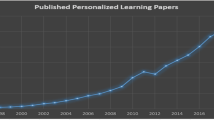Abstract
This communication discusses how automatic speech recognition (ASR) can support universal access to communication and learning through the cost-effective production of text synchronised with speech and describes achievements and planned developments of the Liberated Learning Consortium to: support preferred learning and teaching styles; assist those who for cognitive, physical or sensory reasons find notetaking difficult; assist learners to manage and search online digital multimedia resources; provide automatic captioning of speech for deaf learners or when speech is not available or suitable; assist blind, visually impaired or dyslexic people to read and search material; and, assist speakers to improve their communication skills.
Similar content being viewed by others
References
Bain, K., Basson, S., Wald, M.: Speech recognition in university classrooms. In: Proceedings of the 5th International ACM SIGCAPH Conference on Assistive Technologies. ACM Press, pp. 192–196 (2002)
Banes, D., Seale, J.: Accessibility and inclusivity in further and higher education: an overview. In: Phipps, L., Sutherland, A., Seale J. (eds) Access All Areas: disability, technology and learning, JISC TechDis and ALT, pp. 1–5 (2002)
Bennett, S., Hewitt, J., Kraithman, D., Britton, C.: Making Chalk and Talk Accessible. ACM SIGCAPH Comput Phys Handicapped (73–74):119–125 (2002)
DAISY: Available online at: http://www.daisy.org (accessed 26 May 2005) (2005)
Dolphin: Available online at: http://www.dolphinaudiopublishing.com/products/EasePublisher/index.htm (accessed 26 May 2005) (2005)
Draffan, E.: Dyslexia and technology. In: Phipps, L., Sutherland, A., Seale, J. (eds) Access all Areas: Disability, Technology and Learning. JISC TechDis and ALT, pp 24–28 (2002)
Francis, P.M., Stinson, M.: The C-print speech-to-text system for communication access and learning. In: Proceedings of CSUN Conference Technology and Persons with Disabilities. California State University Northridge (2003)
Hargrave-Wright, J.: JISC technology and standards watch: improvements in hands-free access to computers. Available online at: http://www.jisc.ac.uk/uploaded_documents/tsw_02-06.doc (accessed 20 July 2005) (2002)
Howard-Spink, S.: IBM’s superhuman speech initiative clears conversational confusion. Available online at: http://www.research.ibm.com/thinkresearch/pages/2002/20020918_speech.shtml (2005)
IBM: Available online at: http://www-306.ibm.com/able/solution_offerings/ViaScribe.html (accessed 20 July 2005) (2005)
JM Consulting: Issues paper: teaching and learning infrastructure in higher education: report to the HEFCE. Available online at: http://www.hefce.ac.uk/Pubs/hefce/2002/02_31.htm (accessed 26 May 2005) (2002)
Lambourne, A., Hewitt, J., Lyon, C., Warren, S.: Speech-based real-time subtitling services. Int J Speech Technol 7, pp. 269–279, Kluwer Academic Publishers, Dordrecht (2004)
Leitch, D., MacMillan, T.: Liberated learning initiative innovative technology and inclusion: current issues and future directions for liberated learning research. Saint Mary’s University, Nova Scotia. Available online at: http://www.liberatedlearning.com/ (2003)
Leitch, D., MacMillan, T.: Year II research report on the liberated learning project “Improving Access for Persons with Disabilities Using Speech Recognition Technology” (2001)
Liberated Learning: http://www.liberatedlearning.com/about/index.shtml (accessed 28 August 2007) (2007)
MAGpie: Available online at: http://ncam.wgbh.org/webaccess/magpie/ (accessed 26 May 2005) (2005)
Olsen, F.: 25 Universities pledge to increase research in computing for the disabled. The Chronicle of Higher Education, 22 September 2000 http://chronicle.com/free/2000/09/2000092202t.htm (accessed 4 March 2005)
RNID: Available online at: http://www.rnid.org.uk/howwehelp/research_and_technology/communication_and_broadcasting/virtual_signing/ (accessed 19 July 2005)
Scansoft: Available online at: http://www.scansoft.com/ (accessed 26 May 2005)
Senda: Available online at: http://www.opsi.gov.uk/acts2001/20010010.htm (accessed 19 July 2005) (2001)
Shneiderman, B.: Universal usability. Communications of the ACM, vol. 43, no. 5 http://www.cs.umd.edu/∼ben/p84-shneiderman-May2000CACMf.pdf (accessed 2005-03-04)
Skills for Access: Available online at: http://www.skillsforaccess.org.uk (accessed 19 July 2005)
SMIL: Available online at: http://www.w3.org/AudioVideo/ (accessed 26 May 2005)
Stinson, M., Ross Stuckless, E., Henderson, J., Miller, L.: Perceptions of hearing-impaired college students towards real-time speech to print: Real time graphic display and other educational support services. Volta Rev 90, 341–347 (1988)
Stuckless, R. (Ed). Frank W. Lovejoy Symposium on Applications of Automatic Speech Recognition with Deaf and Hard of Hearing People. Rochester, NY: Rochester Institute of Technology. Available online at: http://www.rit.edu/∼ewcncp/Proceedings.pdf (1997)
Stuckless, R.: Developments in real-time speech-to-text communication for people with impaired hearing. In: Ross, M. (ed.) Communication Access for People with Hearing Loss, pp 197–226. York Press, Baltimore (1994)
WAI: Available online at: http://www.w3.org/WAI (accessed 26 May 2005) (1999)
Wald, M.: Developments in technology to increase access to education for deaf and hard of hearing students. In: Proceedings of CSUN Conference Technology and Persons with Disabilities. California State University Northridge (1999)
Wald, M.: Developments in mobile telecommunications technology to increase access to education for deaf and hard of hearing students. In: Proceedings of Mobile Telecommunications: Encouraging developments for persons with disabilities and elderly people worldwide. DVfR, Heidelberg/Germany, pp. 70–72 (2002)
Wald, M.: ‘Hearing disability and technology’, access all areas: disability, technology and learning. JISC TechDis and ALT, pp 19–23 (2002)
Author information
Authors and Affiliations
Corresponding author
Rights and permissions
About this article
Cite this article
Wald, M., Bain, K. Universal access to communication and learning: the role of automatic speech recognition. Univ Access Inf Soc 6, 435–447 (2008). https://doi.org/10.1007/s10209-007-0093-9
Published:
Issue Date:
DOI: https://doi.org/10.1007/s10209-007-0093-9




